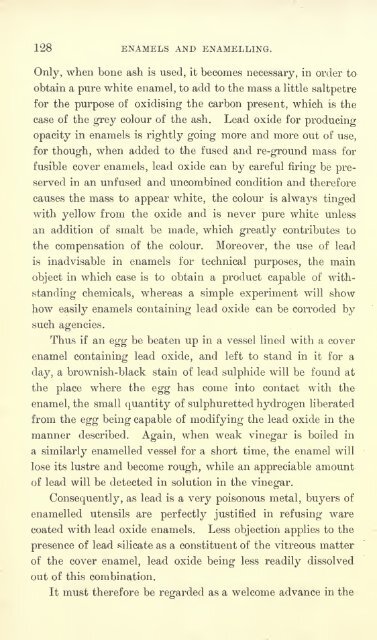Enamels and enamelling; an introduction to the preparation and ...
Enamels and enamelling; an introduction to the preparation and ...
Enamels and enamelling; an introduction to the preparation and ...
Create successful ePaper yourself
Turn your PDF publications into a flip-book with our unique Google optimized e-Paper software.
128 ENAMELS AND ENAMELLING.<br />
Only, when bone ash is used, it becomes necessary, in order <strong>to</strong><br />
obtain a pure white enamel, <strong>to</strong> add <strong>to</strong> <strong>the</strong> mass a little saltpetre<br />
for <strong>the</strong> purpose of oxidising <strong>the</strong> carbon present, which is <strong>the</strong><br />
case of <strong>the</strong> grey colour of <strong>the</strong> ash. Lead oxide for producing<br />
opacity in enamels is rightly going more <strong><strong>an</strong>d</strong> more out of use,<br />
for though, when added <strong>to</strong> <strong>the</strong> fused <strong><strong>an</strong>d</strong> re-ground mass for<br />
fusible cover enamels, lead oxide c<strong>an</strong> by careful firing be pre-<br />
served in <strong>an</strong> unfused <strong><strong>an</strong>d</strong> uncombined condition <strong><strong>an</strong>d</strong> <strong>the</strong>refore<br />
causes <strong>the</strong> mass <strong>to</strong> appear white, <strong>the</strong> colour is always tinged<br />
with yellow from <strong>the</strong> oxide <strong><strong>an</strong>d</strong> is never pure white unless<br />
<strong>an</strong> addition of smalt be made, which greatly contributes <strong>to</strong><br />
<strong>the</strong> compensation of <strong>the</strong> colour. Moreover, <strong>the</strong> use of lead<br />
is inadvisable in enamels for technical purposes, <strong>the</strong> main<br />
object in which case is <strong>to</strong> obtain a product capable<br />
of with-<br />
st<strong><strong>an</strong>d</strong>ing chemicals, whereas a simple experiment will show<br />
}iow easily enamels containing lead oxide c<strong>an</strong> be corroded by<br />
such agencies.<br />
Thus if <strong>an</strong> egg be beaten up in a vessel lined with a cover<br />
enamel containing lead oxide, <strong><strong>an</strong>d</strong> left <strong>to</strong> st<strong><strong>an</strong>d</strong> in it for a<br />
day, a brownish-black stain of lead sulphide will be found at<br />
<strong>the</strong> place where <strong>the</strong> egg has come in<strong>to</strong> contact with <strong>the</strong><br />
enamel, <strong>the</strong> small qu<strong>an</strong>tity of sulphuretted hydrogen liberated<br />
from <strong>the</strong> egg being capable of modifying <strong>the</strong> lead oxide in <strong>the</strong><br />
m<strong>an</strong>ner described. Again, when weak vinegar<br />
is boiled in<br />
a similarly enamelled vessel for a short time, <strong>the</strong> enamel will<br />
lose its lustre <strong><strong>an</strong>d</strong> become rough, while <strong>an</strong> appreciable amount<br />
of lead will be detected in solution in <strong>the</strong> vinegar.<br />
Consequently, as lead is a very poisonous metal, buyers of<br />
enamelled utensils are perfectly justified in refusing ware<br />
coated with lead oxide enamels. Less objection applies <strong>to</strong> <strong>the</strong><br />
presence of lead silicate as a constituent of <strong>the</strong> vitreous matter<br />
of <strong>the</strong> cover enamel, lead oxide being less readily dissolved<br />
out of this combination.<br />
It must <strong>the</strong>refore be regarded as a welcome adv<strong>an</strong>ce in <strong>the</strong>
















